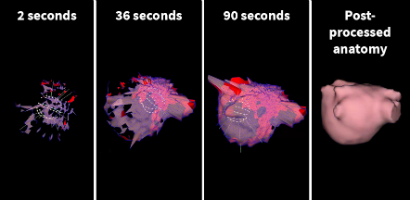A new device that maps the heart could transform the treatment of patients with irregular heart rhythms (arrhythmia).
Atrial fibrillation (AF) is the most common type of arrhythmia and causes an irregular and often abnormally fast heart rate, affecting more than one million people in the UK.
For almost a century, atrial fibrillation has been characterised with electrocardiograms (ECGs). Patients are then treated using ablation, a process where the problematic heart muscle is cauterised or frozen, although the technique is only successful in a proportion of patients.
Now, the 25mm AcQMap tool can be inserted into a patient’s heart via a vein in their groin and during a two-hour process collects information about the heart’s performance. It allows doctors to visualise complex arrhythmia for the first time, leading to a more accurate, bespoke treatment.
“Electrocardiograms of fibrillation have always looked irregular,” said Dr Andrew Grace, Consultant Cardiologist at Royal Papworth Hospital NHS Foundation Trust and principal clinician for the multinational $150M project.
“People used to think AF was chaotic but using the new technology you can clearly see there is an underlying organisation - something our community has been struggling to resolve for a hundred years.
“The ultrasound bounces soundwaves off the inside of the heart’s walls and builds up an image of the chamber. It gathers a massive amount of electrical data, too - the electrodes pick up 150,000 signals every second.
“The AcQMap device then generates unique, personalised images of a person’s heart, which can guide therapy to very specific targets within the heart chambers that are responsible for causing atrial fibrillation.
“Up until now, ablation meant that all patients received broadly similar treatment, therefore it wasn’t bespoke and generated unnecessary collateral damage. This new treatment will allow patients to receive a more tailored procedure to cure their irregular heart rhythm.”
A normal heart rate should be regular and between 60 and 100 beats a minute when resting. In AF, the heart rate is irregular and can sometimes be very fast, possibly considerably higher than 100 beats a minute.
The condition is more common in older people, affecting about seven in every 100 people aged over 65. It costs the NHS up to five per cent of its budget and is a major cause of stroke.
However, it can affect adults of any age, like 50-year-old John Nevins from Braintree in Essex.
“Life with atrial fibrillation was hard work and debilitating”, John recalled. “I was constantly out of breath whenever I tried to play any sport and it got worse and worse over time.

Ultrasound reconstruction of the left atrium using the AcQMap tool. Post-processing is performed to establish the final anatomy.
“I had a standard ablation for atrial fibrillation to try and treat the problem but I was given a low chance of success and sure enough, it didn’t help improve my condition. My AF was due to become more problematic in the coming years and the outcome wasn’t good.
“It was then that I was invited to take part in the AcQMap trial and it immediately had a positive impact. My heart went back into normal rhythm and it has completely transformed my life for the better – I’ve got a new lease of life and enjoying every day to the full.”
Two studies – involving more than 200 patients – have now been completed with the papers published in the US journals JCI Insight and Circulation Arrhythmia Electrophysiology.
“Atrial fibrillation is a heterogeneous condition - it’s different for different people,” added Dr Grace.
“Ablation for the persistent pattern of atrial fibrillation has a less than 50 per cent success rate. We want to change that and make the procedure more personalised and efficient. These initial results from our clinical trial suggest we could improve the success rate for ablations by more than 20 per cent using this new technology.”
The AcQMap technology – funded by US research company Acutus Medical - will give doctors a fresh insight into the condition.
As well as enabling rationalised treatment and delivering improved results, Dr Grace – who is also a Research Group Head at the Department of Biochemistry at the University of Cambridge - said it would pave the way for other new types of scientifically based therapy.
“It’s a phenomenal technology,” he said. “It is the first time anyone has seen unperturbed maps of atrial fibrillation.
“It means you can make all these incredible new measurements of the sources of the heart beats, which can then be mapped onto the genetic makeup of individuals and used as a platform technology to create new drugs. The implications are huge.”
Trudie Lobban MBE, Founder and Chief Executive of the charities Arrhythmia Alliance and AF Association, said: “These conclusions have profound consequences for the many thousands of people living with atrial fibrillation.
“Their lives can be impacted in many ways through fatigue, heart palpitations, and an inability to work or even go out because of the symptoms. Therefore, for people to still be in a normal rhythm one year after surgery makes those everyday tasks so much easier and the risk caused by AF of heart failure or AF-related stroke is hugely reduced.”
